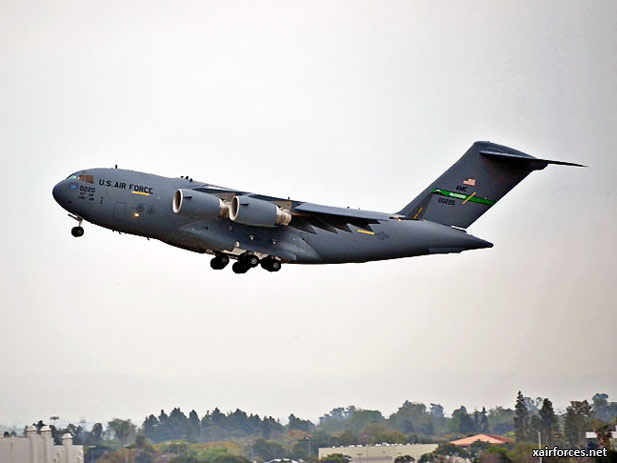
Boeing delivers U.S. Air Force's 220th C-17

Boeing delivered the U.S. Air Force's 220th C-17 Globemaster III during a March 27 ceremony at its Long Beach, Calif., final assembly facility.
The airlifter is pictured here as it lifted off from Long Beach on its way to a new assignment at Joint Base Lewis-McChord, Wash. Accepting delivery of the Air Force’s newest C-17, and the last C-17 for McChord, was Lt. Gen. Darren McDew, Commander, 18th Air Force, Scott Air Force Base, Ill.
BOEING C-17 GLOBEMASTER III
Mission:
The C-17 Globemaster III is the newest, most flexible cargo aircraft to enter the airlift force. The C-17 is capable of rapid strategic delivery of troops and all types of cargo to main operating bases or directly to forward bases in the deployment area. The aircraft can perform tactical airlift and airdrop missions and can transport litters and ambulatory patients during aeromedical evacuations when required. The inherent flexibility and performance of the C-17 force improve the ability of the total airlift system to fulfill the worldwide air mobility requirements of the United States.
The ultimate measure of airlift effectiveness is the ability to rapidly project and sustain an effective combat force close to a potential battle area. Threats to U.S. interests have changed in recent years, and the size and weight of U.S.-mechanized firepower and equipment have grown in response to improved capabilities of potential adversaries. This trend has significantly increased air mobility requirements, particularly in the area of large or heavy outsize cargo. As a result, newer and more flexible airlift aircraft are needed to meet potential armed contingencies, peacekeeping or humanitarian missions worldwide. The C-17 is capable of meeting today's demanding airlift missions.
Features:
Reliability and maintainability are two outstanding benefits of the C-17 system. Current operational requirements impose demanding reliability and maintainability. These requirements include an aircraft mission completion success probability rate of 92 percent, only 20 aircraft maintenance man-hours per flying hour, and full and partial mission availability rates of 74.7 and 82.5 percent, respectively. The Boeing warranty assures these figures will be met.
The C-17 measures 174 feet long (53 meters) with a wingspan of 169 feet, 10 inches (51.75 meters). The aircraft is powered by four, fully reversible, Federal Aviation Administration-certified F117-PW-100 engines (the military designation for the commercial Pratt & Whitney PW2040), currently used on the Boeing 757. Each engine is rated at 40,440 pounds of thrust. The thrust reversers direct the flow of air upward and forward to avoid ingestion of dust and debris. Maximum use has been made of commercial off-the-shelf equipment, including Air Force-standardized avionics.
The aircraft is operated by a crew of three (pilot, co-pilot and loadmaster), reducing manpower requirements, risk exposure and long-term operating costs. Cargo is loaded onto the C-17 through a large aft door that accommodates military vehicles and palletized cargo. The C-17 can carry virtually all of the Army's air-transportable equipment.
Maximum payload capacity of the C-17 is 170,900 pounds (77,519 kilograms), and its maximum gross takeoff weight is 585,000 pounds (265,352 kilograms). With a payload of 169,000 pounds (76,657 kilograms) and an initial cruise altitude of 28,000 feet (8,534 meters), the C-17 has an unrefueled range of approximately 2,400 nautical miles. Its cruise speed is approximately 450 knots (.74 Mach). The C-17 is designed to airdrop 102 paratroopers and equipment.
The design of the aircraft allows it to operate through small, austere airfields. The C-17 can take off and land on runways as short as 3,500 feet (1,064 meters) and only 90 feet wide (27.4 meters). Even on such narrow runways, the C-17 can turn around using a three-point star turn and its backing capability.
Background:
The C-17 made its maiden flight on Sept. 15, 1991, and the first production model was delivered to Charleston Air Force Base, now known as Joint Base Charleston, S.C., on June 14, 1993. The first squadron of C-17s, the 17th Airlift Squadron, was declared operationally ready Jan. 17, 1995. The Air Force originally programmed to buy 120 C-17s.Current budget plans increased the total number to 223 aircraft.
The C-17 is operated by Air Mobility Command at Travis AFB, Calif.; Dover AFB, Del.; Joint Base Lewis-McChord, Wash.; Joint Base Charleston, S.C., and Joint Base McGuire-Dix-Lakehurst, N.J.
The Air National Guard flies C-17s from the 172d Airlift Wing, Jackson, Miss., and the 105th Airlift Wing, Stewart ANGB, N.Y. Additionally, Air Force Materiel Command operates two C-17s at Edwards AFB, Calif., and Pacific Air Forces operates aircraft at Joint Base Elmendorf-Richardson, Alaska, and Joint Base Pearl Harbor-Hickam, Hawaii.
The Air Force Reserve Command operates aircraft at March Air Reserve Base, Calif., and Wright Patterson AFB, Ohio. Air Education and Training Command has 17 aircraft at Altus AFB, Okla.
Source: Boeing News - 27 March 2013
Photo: The U.S. Air Force 220th Boeing C-17 Globemaster III (Photo by boeingimages.com)
(27.03.2013)
|